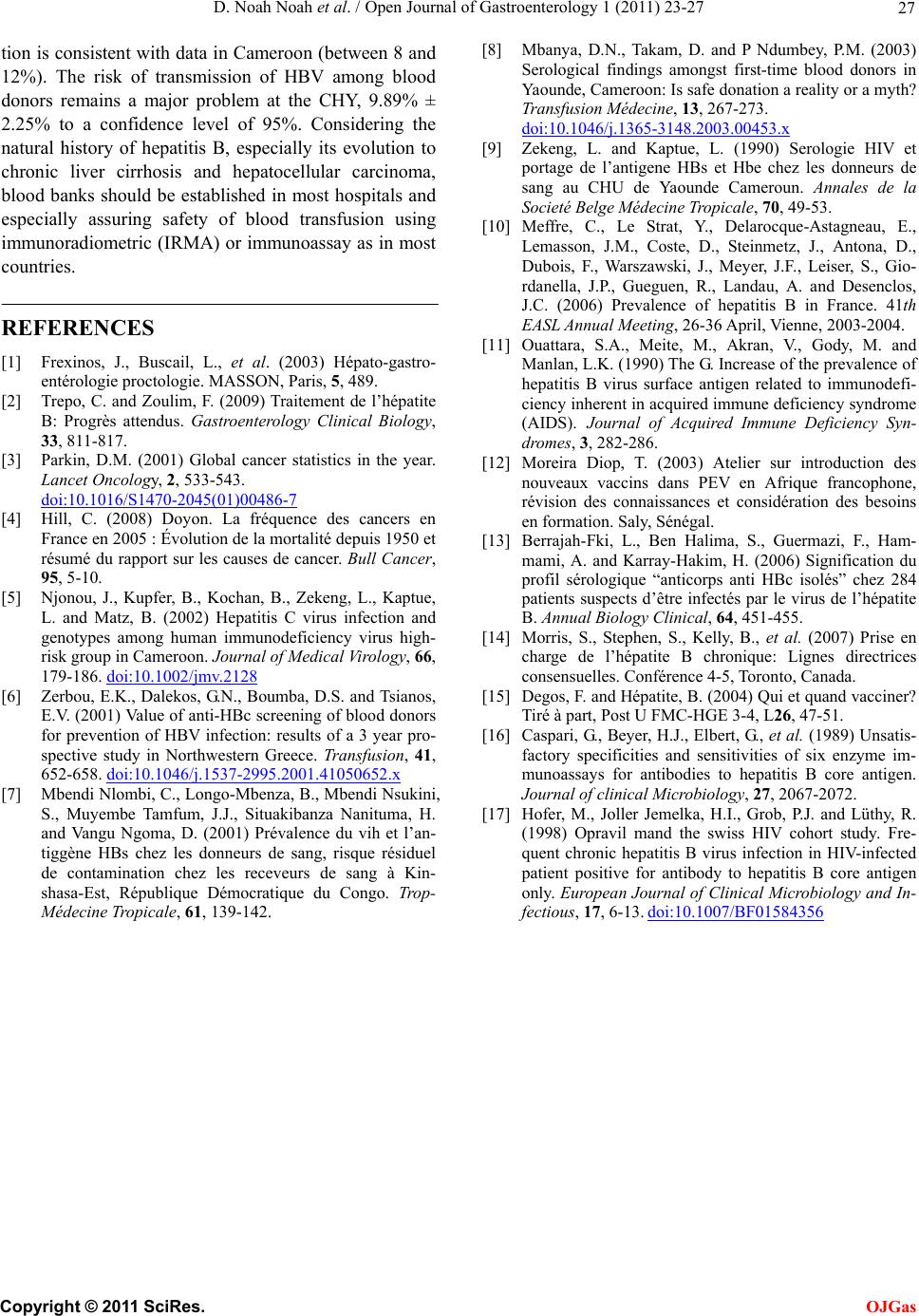
D. Noah Noah et al. / Open Journal of Gastroenterology 1 (2011) 23-27
Copyright © 2011 SciRes.
27
[8] Mbanya, D.N., Takam, D. and P Ndumbey, P.M. (2003)
Serological findings amongst first-time blood donors in
Yaounde, Cameroon: Is safe donation a reality or a myth?
Transfusion Médecine, 13, 267-273.
doi:10.1046/j.1365-3148.2003.00453.x
tion is consistent with data in Camero on (between 8 and
12%). The risk of transmission of HBV among blood
donors remains a major problem at the CHY, 9.89% ±
2.25% to a confidence level of 95%. Considering the
natural history of hepatitis B, especially its evolution to
chronic liver cirrhosis and hepatocellular carcinoma,
blood banks should be established in most hospitals and
especially assuring safety of blood transfusion using
immunoradiometric (IRMA) or immunoassay as in most
countries.
[9] Zekeng, L. and Kaptue, L. (1990) Serologie HIV et
portage de l’antigene HBs et Hbe chez les donneurs de
sang au CHU de Yaounde Cameroun. Annales de la
Societé Belge Médecine Tropicale, 70, 49-53.
[10] Meffre, C., Le Strat, Y., Delarocque-Astagneau, E.,
Lemasson, J.M., Coste, D., Steinmetz, J., Antona, D.,
Dubois, F., Warszawski, J., Meyer, J.F., Leiser, S., Gio-
rdanella, J.P., Gueguen, R., Landau, A. and Desenclos,
J.C. (2006) Prevalence of hepatitis B in France. 41th
EASL Annual Meeting, 26-36 April, Vienne, 2003-2004.
REFERENCES [11] Ouattara, S.A., Meite, M., Akran, V., Gody, M. and
Manlan, L.K. (1990) The G. Increase of the prevalence of
hepatitis B virus surface antigen related to immunodefi-
ciency inherent in acquired immune deficiency syndrome
(AIDS). Journal of Acquired Immune Deficiency Syn-
dromes, 3, 282-286.
[1] Frexinos, J., Buscail, L., et al. (2003) Hépato-gastro-
entérologie proctologie. MASSON, Paris, 5, 489.
[2] Trepo, C. and Zoulim, F. (2009) Traitement de l’hépatite
B: Progrès attendus. Gastroenterology Clinical Biology,
33, 811-817.
[3] Parkin, D.M. (2001) Global cancer statistics in the year.
Lancet Oncology, 2, 533-543.
doi:10.1016/S1470-2045(01)00486-7
[12] Moreira Diop, T. (2003) Atelier sur introduction des
nouveaux vaccins dans PEV en Afrique francophone,
révision des connaissances et considération des besoins
en formation. Saly, Sénégal.
[4] Hill, C. (2008) Doyon. La fréquence des cancers en
France en 2005 : Évolution de la mortalité depuis 1950 et
résumé du rapport sur les causes de cancer. Bull Cancer,
95, 5-10.
[13] Berrajah-Fki, L., Ben Halima, S., Guermazi, F., Ham-
mami, A. and Karray-Hakim, H. (2006) Signification du
profil sérologique “anticorps anti HBc isolés” chez 284
patients suspects d’être infectés par le virus de l’hépatite
B. Annual Biolog y Clinical, 64, 451-455.
[5] Njonou, J., Kupfer, B., Kochan, B., Zekeng, L., Kaptue,
L. and Matz, B. (2002) Hepatitis C virus infection and
genotypes among human immunodeficiency virus high-
risk group in Cameroon. Journal of Medical Vi rology, 66,
179-186. doi:10.1002/jmv.2128
[14] Morris, S., Stephen, S., Kelly, B., et al. (2007) Prise en
charge de l’hépatite B chronique: Lignes directrices
consensuelles. Conférence 4-5, Toronto, Canada.
[15] Degos, F. and Hépatite, B. (2004) Qui et quand vacciner?
Tiré à part, Post U FMC-HGE 3-4, L26, 47-51.
[6] Zerbou, E.K., Dalekos, G.N., Boumba, D.S. and Tsianos,
E.V. (2001) Va lue of anti-HBc screening of blood donors
for prevention of HBV infection: results of a 3 year pro-
spective study in Northwestern Greece. Transfusion, 41,
652-658. doi:10.1046/j.1537-2995.2001.41050652.x
[16] Caspari, G., Beyer, H.J., Elbert, G., et al. (1989) Unsatis-
factory specificities and sensitivities of six enzyme im-
munoassays for antibodies to hepatitis B core antigen.
Journal of clinical Microbiology, 27, 2067-2072. [7] Mbendi Nlombi, C., Longo-Mbenza, B., Mbendi Nsukini,
S., Muyembe Tamfum, J.J., Situakibanza Nanituma, H.
and Vangu Ngoma, D. (2001) Prévalence du vih et l’an-
tiggène HBs chez les donneurs de sang, risque résiduel
de contamination chez les receveurs de sang à Kin-
shasa-Est, République Démocratique du Congo. Trop-
Médecine Tropicale, 61, 139-142.
[17] Hofer, M., Joller Jemelka, H.I., Grob, P.J. and Lüthy, R.
(1998) Opravil mand the swiss HIV cohort study. Fre-
quent chronic hepatitis B virus infection in HIV-infected
patient positive for antibody to hepatitis B core antigen
only. European Journal of Clinical Microbiology and In-
fectious, 17, 6-13. doi:10.1007/BF01584356
OJGas